![How to Make Kombucha at Home [Ultimate Guide with Recipe]](https://myfermentedfoods.com/wp-content/uploads/2018/05/kombucha-feature-photo-1-1024x614.jpg)
Fermented drinks started in Northeast China and were praised for their healing. In China, kombucha is known as the “Immortal Health Elixir” and its origins started in the Tsing Dynasty over 2,000 years ago.
The story is that it was brought to Japan by Dr. Kombu to treat the Emperor of digestive problems.
Of course some of us will eat herbs or drink special concoctions, of any kind, if it will increase our chances of longevity!
Many stories exist on line about the start of this vinegary drink, many handed down from family to family but never recorded.
Table of Contents
History of Fermented Kombucha
The name Kombucha was first definitively recorded in Russia and the Ukraine, in the early 19th century. Then it expanded rapidly due to the World War 1 POW’s, (prisoners of war), in Germany it became a popular folk remedy.
Kombucha expanded again in the 1960’s following a report done in Switzerland comparing its health benefits to yogurt. Yogurt is already thought of as a ‘yummy’ food by a lot of us.
In the 1990’s Sandor Katz, a leading fermentation expert, author of The Art of Fermentation, revived the popularity of Kombucha, due to its belief by consumers, as to its powerful aid to medical problems.
How to Make Kombucha Tea
The things you need to do before you begin:
- Consider where you can get supplies, at home or on the internet.
- What kind of cost is involved?
- Recommended use of water free of contaminants, chlorine or fluorides, the best is spring water or distilled water.
- Do you know what kind of base you want? Black or Green tea? Or flavoring?
- Review how to ferment ahead of starting production.
- Pick up pH strips to check the acid pH of your fermentation, it needs to be 3.5 to 2.5 for good growth.
- What do you want to use as a starter, Kombucha store bought product or white vinegar. Or do you have a friend who is giving you a cup of home brew?
- Glass bottles and storage space for finished products.
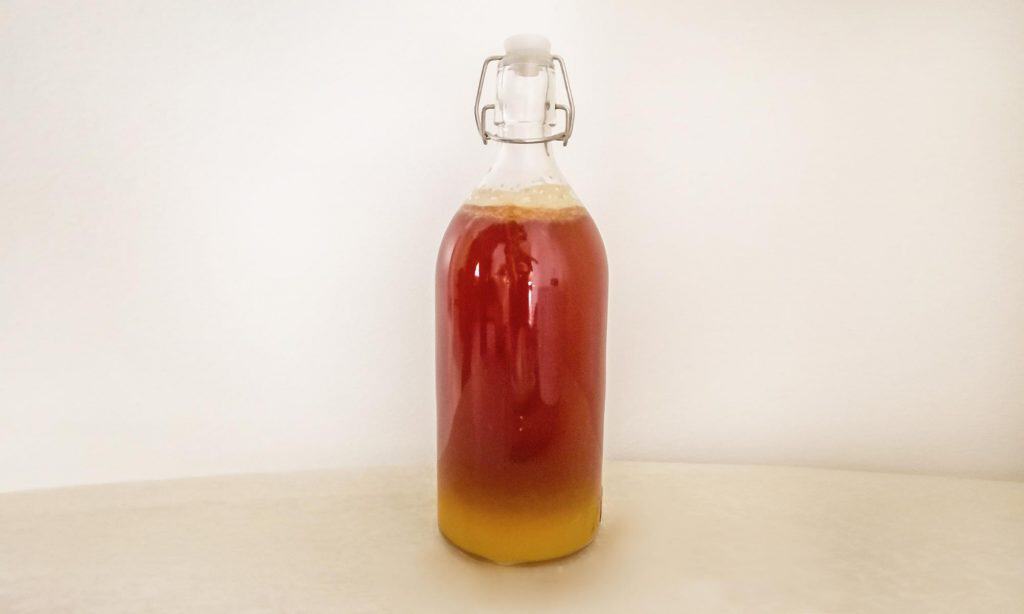
Health Benefits of Kombucha
Kombucha is simply made from tea and sugar, and it has been consumed for many years in many different countries around the world.
Kombucha is fermented, made from “living” bacteria and yeast which forms a SCOBY. (More on that later) This is a mushroom like film that produces acetic acid (like in vinegar) with traces of alcohol and gases that make it carbonated.
This growth is sometimes referred to as a ‘Mushroom’, which is what it may look like, even though it has no relation to mushrooms themselves. The SCOBY is more so like the ‘Mother’ as in apple cider vinegar.
Benefits of Drinking Kombucha
- High anti-oxidants and acids produced from tea and during the brewing- fermentation cycle.
- Antibacterial properties, which may sound backwards, but this is GOOD bacteria and it rids body of BAD bacteria. It is a Probiotic!
- Helps your digestive and your immune system.
- Glucosamines, compounds that are by products of brewing, is associated with cartilage and collagen production; which is why many say it helps reduce arthritis symptoms.
- May help manage type 2 diabetes since it slows digestion of carbohydrates reducing sugar levels.
- May reduce Heart disease by lowering cholesterols LDL level and improving HDL levels.
- Helps maintain healthy liver by protecting it from oxidative stress and damages from acetaminophen overdose.
Kombucha contains many of the B vitamins, enzymes and probiotics, the healthy bacteria, needed by your gut.
There have not been many studies to prove or disapprove its promoted probiotic function.
Kombucha Nutrition
Most 16 oz. drinks equal about 60 calories; kombucha usually has about 14 grams of carbohydrates, 4 grams of sugar and 20 mgs of sodium. (Unless it contains added sugar)
Kombucha is fat free and does not contain any protein.
- It provides several kinds of good bacteria: Bacillus coagulans, S, Boulardii, Gluconacetobacter, Lactobacillus and Zygosaccharomyces.
- It contains EGCG (epi-gallocatechin gallate) a polyphenol or antioxidant from tea that helps your metabolic and cardiovascular systems.
- It has Glucuronic acid, which is a compound that binds to substances, i.e. hormones, drugs and toxins to facilitate the transport and elimination from the body.
- Lactic acid as other similar acids possesses immunological properties that down regulate pro-inflammatory responses.
- Acetic acid is a by -product of fermentation. It is also known as ethanoic acid, a compound recognized for giving a vinegary sour taste. This acid has many uses, and is great to help balance the pH of the body system.
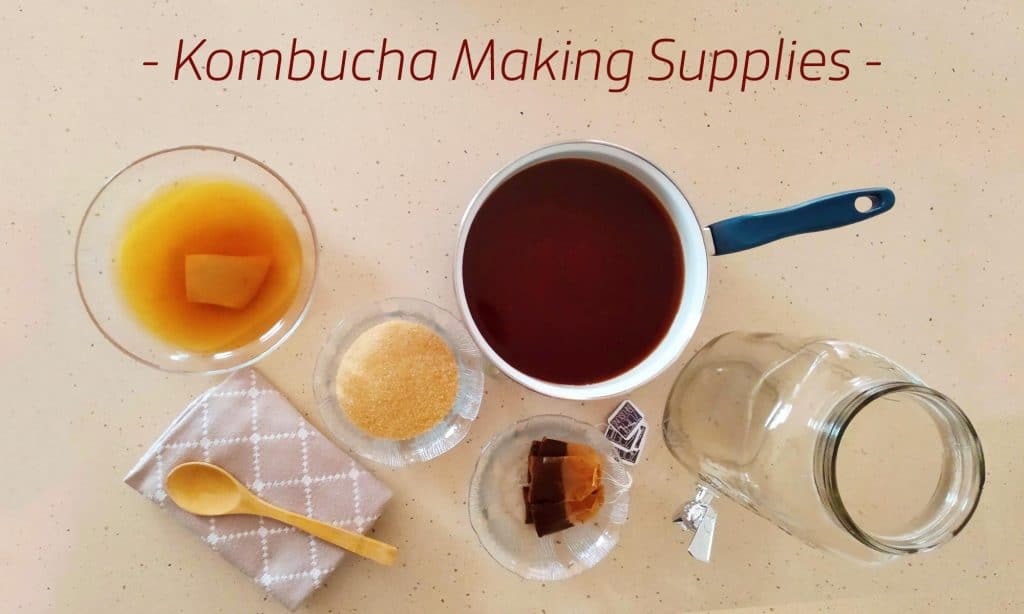
Many experts recommend starting with Black tea for the first time for better results even though you have a lower amount of anti-oxidants.
If you use Green tea you have a higher antioxidant level from the increased number of polyphenol compounds.
The use of Tea especially Green tea in Making Kombucha increases your Benefits:
- By helping to reduce your total calories.
- Decreases belly fat.
- Decreases cholesterol and triyglercides
- Lowers inflammation.
- Helps you lose weight
- Plus all other benefits discussed above under drinking Kombucha.
Some believe that drinking Kombucha may help decrease growth and spread of abnormal cells. This could be due to the acids present in this drink which can help balance the pH from more acidic to more alkaline.
DO not use pasteurized Kombucha, just like pasteurized milk, during this process you lose good bacteria because they will be dead or unhealthy.
So you will not have a good product unless you use fresh un-pasteurized starter for your Kombucha.
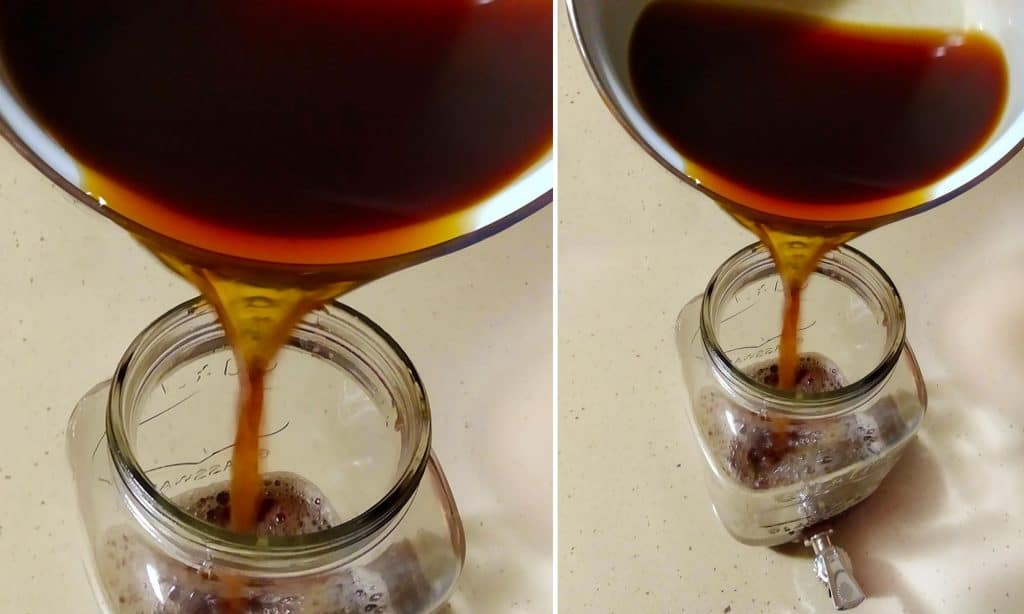
Kombucha Studies Show:
Even though not well studied there is a well confirmed body of evidence that says Kombucha contains high antioxidants, it detoxifies and protects the body.
Many studies were done in Russia and Germany from the 1920’s to 1930’s with much of the focus on improvement in digestion and for diabetes.
A 2012 study discovered how Kombucha can help improve your mental state especially as a “functional food” during space exploration.
This is due to Kombucha’s ability to regulate ”the communication between the gut-brain axis” because of its usefulness in minimizing effects of depression and anxiety. In particular it was found to help astronauts and others in extreme working conditions, like miners.
Laboratory studies reported in 2012, by the Journal of Food Chemistry, found that Kombucha is an effective anti-microbial potential, against the bacteria of Staphylococcus, E. coli, Salmonella and Campylobacter jejuni, which is the most common cause of food poisoning!
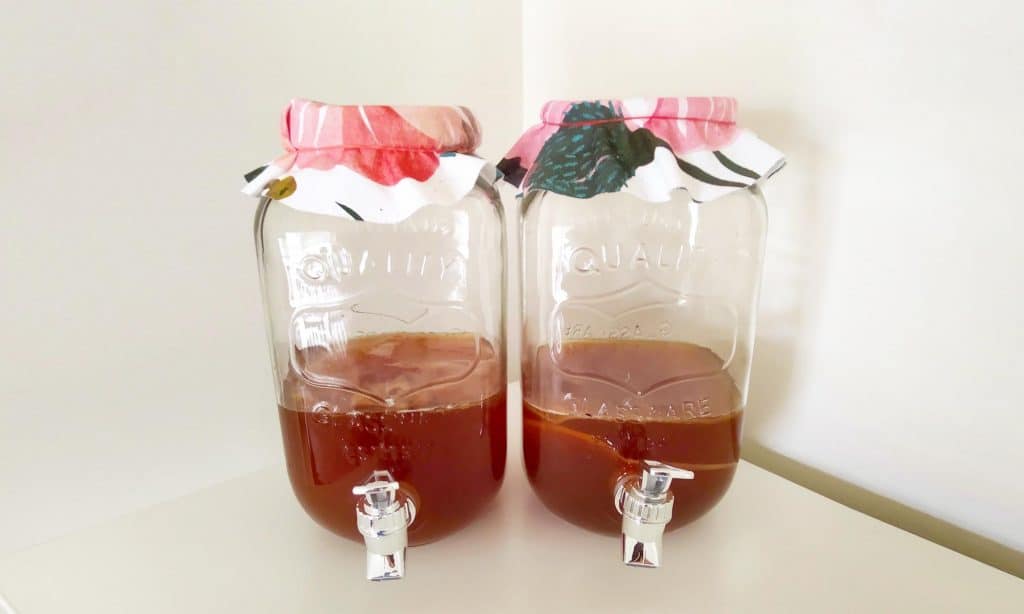
The Journal of Medicinal Food reported in 2014 on an animal study that Kombucha helped with detoxing and immune support of infective disorders.
Many of the studies to date have been from the use of tea in making Kombucha as teas have the high antioxidant compounds that are effective antimicrobials along with the acetic acid formation of the fermented drink.
Presently most studies have been done on rats only, very few human studies to date.
Kombucha Recipes
Kombucha makes a great substitute drink for your daily sodas.
This drink will help to lower your sugar intake, that is, if you are a daily soda drinker!
You do have to use sugar when making Kombucha but this sugar is only to feed the bacteria and yeast of the SCOBY. There are only small amounts of sugar left in the drink itself. SCOBY is an acronym for “Symbiotic Colony of Bacteria and Yeast”.
Making your own Kombucha saves you money from continually buying commercial drinks.
Making Kombucha is not as intimidating as it sounds but it is important to understand the fermenting process.
It is easy to make your own Kombucha brew at home.
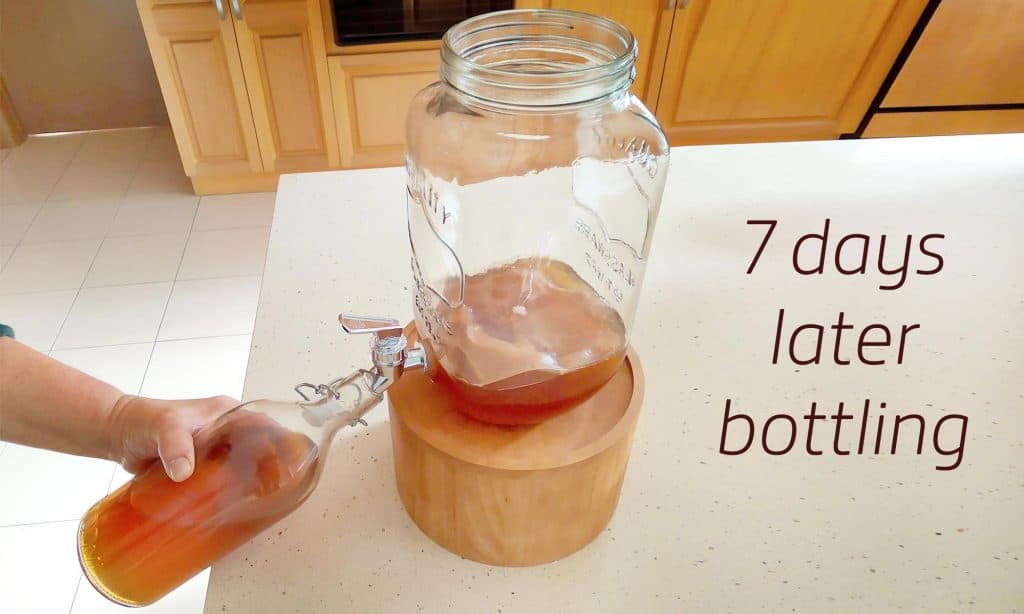
The Basic Kombucha Recipe
First Kombucha fermentation
You will need one cup of Kombucha plus your SCOBY per gallon of your brew to begin making your basic brew. This is your 1st fermentation.
Read my post on HOW TO MAKE SCOBY first, if you would like detailed instructions to make your own SCOBY. Otherwise, you can No products found. online.
Print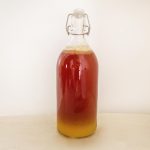
The Basic Kombucha Recipe
- Total Time: 7 days including fermentation
- Yield: 2.5 quarts 1x
Ingredients
- 2 quarts of purified water, chlorine free, (spring or distilled water), sterilize your glass container with hot water before using
- 4–6 Black tea bags
- 1 cup of white sugar, organic is preferred
- SCOBY colony
- 1–2 cups of fermented Kombucha
Instructions
- Use a pot or tea kettle to boil 4 cups (1 liter) of purified water.
- Add your tea bags to pot or pour boiling water over tea bags to brew in a brewing vessel.
- Steep your tea for 7 to 15 minutes, after steeping removes the tea bags.
- Add sugar and stir to dissolve.
- Add 2 quarts (2 liters) of purified water to your brew container, and then add hot brewed tea.
NOTE: leave space at the top of the container to add your starter liquid and SCOBY culture plus a 1-2 inch breathing room. - Check to make sure tea is Body Temperature, Use a clean finger to check.
- When the temperature is good, add your starter liquid and your SCOBY.
- Cover the top with cloth or white coffee filter, rubber band top to a close fit.
- Now you can send out loving vibes, blessings or commune with your culture.Place the container in a warm, ventilated area, out of direct sun, for 5-14 days (this depends on your taste preference). 75-85 degrees F, (24-28 C) is best.
- After 5 days, taste your Kombucha with a straw by going beneath the SCOBY culture. If too sweet try brewing it a few more days. Check it daily for your preference in taste.
- Set aside your SCOBY and 1-2 cups of starter liquid for your next brew.
- Prep Time: 20 minutes
Your first fermentation is now done!
You can do more basic fermentations by changing the kind of tea you use. Green tea, Yerba Mate, White tea or Oolong tea will vary your taste and the amount of anti-oxidants in your Kombucha.
The longer it ferments; the Kombucha will become more vinegary in taste.
If you like a fizzy drink, place Kombucha in a bottle for about a week and it will become fizzy or do a 2nd fermentation.
Equipment and Ingredients for Making Kombucha
Notes and Tips
The first starter ingredient needed is the SCOBY a living, thriving colony of bacteria and yeast.
It is best to get this starter fresh from a brewer who has a Mother SCOBY or a “baby SCOBY” or buy one online, be sure it’s from a reputable company like Kombucha Kamp.
No products found.
It is not recommended to use a dehydrated SCOBY which can produce a weak brew at best or maybe no brew at all!
Or you could grow your own SCOBY using commercial or pre-made bottle of Kombucha, this is not a fast process but it is simple.
To begin you will need 1-2 cups of liquid brewed Kombucha.
You may need to buy a bottle of commercial Kombucha or talk to a friend or someone who is already brewing and willing to impart you with a few cups.
You will need one cup of Kombucha plus your SCOBY per gallon to begin making your basic brew. This is your 1st fermentation.
You can use 2 large family size tea bags or 8-10 small tea bags.
Make sure your tea temperature is COOL before adding your SCOBY, if to hot you could kill off some of the bacteria in the culture.
You could use a heating pad to lay your bottles on if your kitchen is too cold. (Like maybe in very cold climates)
A gallon size glass jar works best for brewing. Or you can use a 4-5 quart container even if not the exact in size. You can use ceramic or plastic. But preference is glass and never metal.
- EASY FILTER: The premium pure cotton cloth keeps dirt, fruit flies, bugs and other particles from getting into your kombucha brew, while allowing air to come into the jar to assist with the fermentation. A rubber band keeps it in place.
- GLASS IS BEST: Using a glass bottle like this one is better for the flavor of the kombucha or other beverages you are brewing, and it doesn't contain BPA or other toxins that other plastic containers may have.
- MASON STORAGE JAR: Aside from brewing and fermenting kombucha tea, you can use this as a storage jar to keep grains, legumes and other liquids in your fridge, pantry, or on your counter top.
- PLASTIC LIDS: Better than metal lids, these plastic lids do not rust, corrode or give any metallic taste to the pure brew of your kombucha.
- 1 COMPLETE SET: This Kombucha kit has almost everything you need to brew & ferment your own kombucha or any tea. The mason style glass jar comes with a cotton cheese cloth lid, and elastic band.
Always clean and sanitize, in boiling water or dishwasher, all your bottles and utensils you use. This is so to prevent any contamination. You can also clean it with vinegar.
Check out my review of the BEST Kombucha Brewing Kits.
Kombucha Second Fermentation:
Flavors From Around the World
After the Basic Kombucha recipe is brewed you can then add fruits, herbs and spices to make up many flavor varieties!
The 2nd Kombucha fermentation is when it gets FIZZY which of course most children and yes, us adults too, really like!
If you like sweet you can use fruits, blended, juiced or squeezed.
If you want the benefits of herbs you can add them whole, or steep as a tea.
Adding spices can really flavor your Kombucha like cinnamon or basil or cayenne!
“Bottling” is often the term used for the second fermentation because generally that is when you are pouring from your gallon size to smaller bottles.
- ELEVATE YOUR KOMBUCHA, WITH BELLEMAIN : Bringing artisanal style to an ancient practice, Bellemain’s signature Grolsch glass bottles are designed to look good and last for ages
- PERFECT FOR HOME MADE BEVERAGES: Beer, soda pop, kombucha, keffir, vinegar, cider, flavored cooking oil, herbal extracts and more.
- AIR-TIGHT, REUSABLE CAP: Silicone gasket seal with stainless steel wire bail prevents leaks, keeps contents fresh, and can be opened and reclosed for repeated use.
- FREE OF HARMFUL LEAD AND CADMIUM: Thick, sturdy glass won't absorb odors, flavors or stains, or leach dangerous chemicals like cadmium or lead like other containers.
- EASY TO CLEAN: Cap and bail slide off easily for convenient, thorough cleaning.
Easy Juicy Kombucha Recipe
- Use another clean gallon size or 5 quart size jar.
- Pour 1 quart of the juice flavor of your choice (I used freshly squeezed orange juice) into the clean jar or you can use several smaller jars filling them 1/5 full.
- Pour your 1st brewed Kombucha into the jar or jars but leave an inch open at the top.
Note: Do not empty your 1st fermented batch, leave 1 cup of Kombucha plus the SCOBY in the jar. Or take this out first before pouring for the 2nd brewing.
You can switch these to a new clean jar to continue with a new 1ST fermentation batch.
- Tightly cap jars with juicy Kombucha and leave at room temperature for another 2-7 days until carbonated (fizzy) to your taste.
- Refrigerate your bottle.
- Enjoy your new drink!
Remember to use plastic lids not metal for your jars.
You can find jars at online stores or reuse Kombucha bottles you bought.
It is recommended to use bottles with long necks versus a mason jar because they seem to be better at creating the fizzy taste you want.
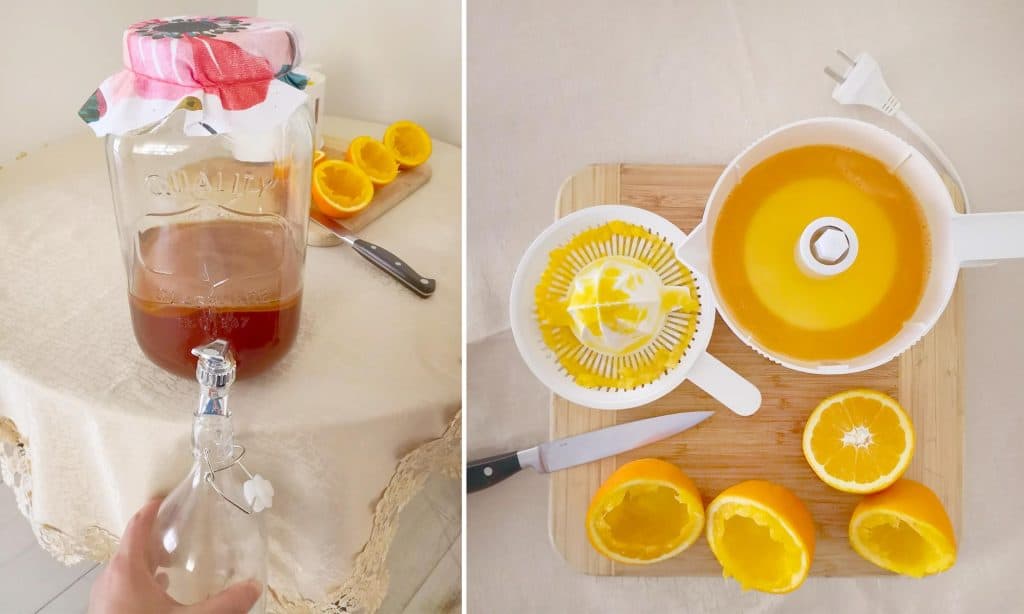
Advantages of Kombucha Batch Brewing:
- Good if you only need a glass or two per day; this could depend on how many people are in the family.
- It uses a smaller size container usually a one gallon.
- Uses less space on your counter.
Disadvantages of Kombucha Batch Brewing
- It needs weekly maintenance.
- Have to handle moving SCOBY with every batch, leading to possible contamination.
- Tends to get moldy more often since there are more steps.
Kombucha Flavored Drink Recipes
Blue Ginger Kombucha
Something sweet and tangy with some Zing! Ginger is a great anti-inflammatory, good for tummy upset and blueberries are the prize for the highest antioxidant out of all the berries!
- Take 1 cup of fresh or frozen blueberries with fresh grated ginger and make simple syrup. Smash those blueberries to get all their goodness.
- Add some sugar in a cup of water and simmer this mixture with your blueberries until well mixed and sugar is dissolved.
- Take it off the heat and let it cool to room temperature.
- Pour it over into a clean new gallon or 4 quart jar. Then pour your 1st fermented Kombucha and add it to your new jar or divide it up if using smaller jars.
Remember to remove your SCOBY and 1 cup from original jar for another 1st brew.
- Cap jars and let it sit for the 2nd fermentation for 2-7 days in a warm spot, to produce the fizzy taste you desire.
- Refrigerate, SLOWLY remix before uncapping and drinking.
- Share and bring happiness to the world!
Human beings have recognized the magic and power of fermentation for as long as we have been human.
Sandor E. Katz
Once you have tried brewing Kombucha, making batches and working with a SCOBY then you will find out how good this drink is and how often you want it!
If like many, you love your Kombucha and only want more of it then continuous brewing is probably the answer.
Continuous Brew Kombucha
Continuous brewing is the easiest and simplest way to make Kombucha.
All your optimum health benefits and all your nutrients are ready and available daily.
Advantages and Disadvantages of Kombucha Continuous Brewing
Smarter, safer, more nutritious and even better taste!
It’s true, continuous Kombucha brewing is so easy and cost effective. It saves you a lot of time, mess and money.
Advantages:
- Use one large 2.5 gallon container to both ferment and dispense with a spigot versus trying to pour it over from a large gallon container.
- This lowers risk of contamination associated with batch brewing. You can add your 2nd ferment to other bottles for flavoring or flavor as you pour since it is already a continuous brew it will be fizzy.
It’s easy to add fresh tea to the top of your continuous container whenever low. Just refill as much as you take out daily.
- You have a more continuous sweet to tart taste balance.
- You only need to add 25% to your container of new tea nutrients. You leave in the SCOBY.
- The SCOBY has less chance to become MOLDY, protects it from bad bacteria and keeps it healthier.
- Low maintenance since it continually brews on its own.
- Less messy and less clean up versus poring over and less cleaning of new bottles every batch you brew.
- The cost is much lower since you use less bottles, and more efficient use of your time.
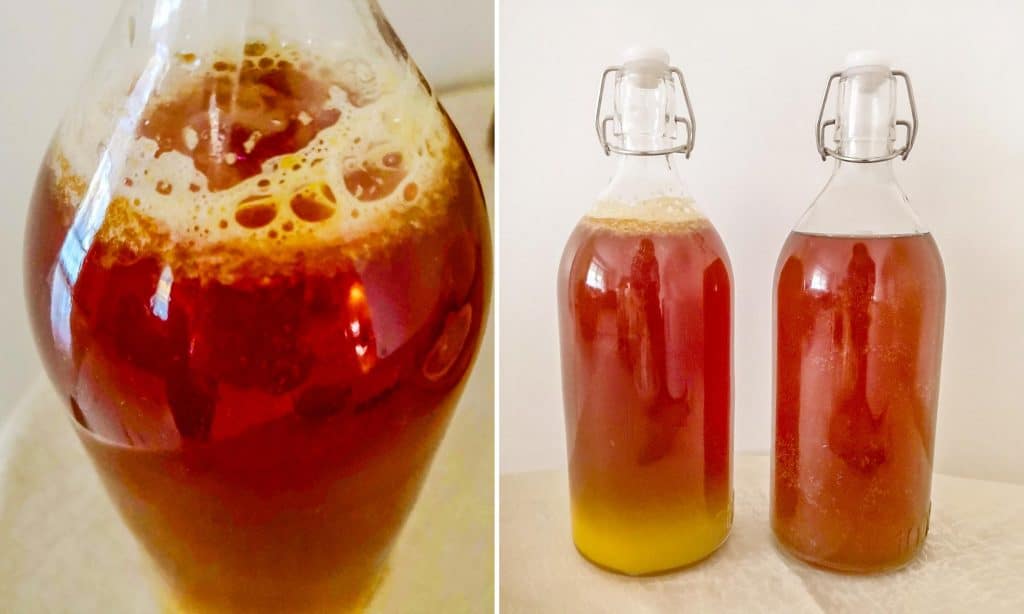
Disadvantages
- It is more expensive to get started. Larger vessels are more costly.
- It brews faster so if you do not drink enough it may go from a sweet-tart taste to a vinegary taste much faster.
- Having an excess might tempt you to drink more than an 8 ounce glass per day. But for some people drinking more is not a good benefit.
- Benefits can negate your Kombucha drinking if you have to much sugar, if you have to much caffeine or even too much probiotics. It is not always true that more is better. There are some of us more sensitive to greater amounts of both caffeine and sugar.
Increased benefits of Continuous Brewing of Kombucha
- In some countries from around the world studies have shown that the best acids for your body are produced by Kombucha after 2- 3 weeks! In batch brewing you wait 5-14 days before you pour over to start your 2nd fermentation. So you have fewer healthy acids.
- It increases the amount of good bacteria, so you get even more good probiotics.
- Researchers have discovered that these acids pick up toxins and allow the body to flush out your toxic livers and gut more efficiently!
- People are feeling so much healthier and lighter.
Alert: One method versus another is not always better for everyone. It depends on your circumstance if batch or continuous brewing might be better for you.
Choosing the Best Equipment for Continuous Kombucha Brewing
- You need the correct kind of Brewing container, a 1-5 gallon container with a spigot. For over ½ of the liquid will remain in the container continuously.
- Covers for your container to protect the SCOBY, and to let it ferment. They should be used to prevent fruit flies from getting in and still permit oxygen to penetrate. There are many colorful cloth covers available on-line.
- Cleaning the Vessel before use: it is best to avoid anti-bacterial soap-if you forget… do rinse with vinegar to remove soap residue.
- Spigots for your container should not be metal and should be BPA free plastic, stainless steel or wood. Make sure your spigots have not used glue to adhere to the vessel.
- A stirring utensil.
Instead of purchasing all these things separately, I recommend getting a kombucha brewing kit that has everything you need to get you started.
- BREW KOMBUCHA AT HOME. Unlock the ancient secrets of Kombucha at home, with the EverBru Kombucha Deluxe Starter Kit!
- INCLUDES 1.75 GALLON GLASS FERMENTER JAR AND OUR STAINLESS STEEL CARAFE: The choice is yours; make single batches or make a continuous brew of delicious Kombucha Tea
- INLCUDES THE SCOBY, unlike other starter kits. A Symbiotic Culture of Bacteria and Yeast (SCOBY) ferments a sweet tea mixture to produce a refreshing, yet tart, tea beverage.
- EASY TO BREW with quality ingredients. We include enough to get you started with 2 one-gallon batches.
- COMPLETE KIT INCLUDES: Little Big Mouth Bubbler Glass Fermenter (1.75 gallon capacity), Live SCOBY Culture, Fermenter’s Favorites Rack Magic Mini Siphon and Tubing, Fermagraf° Adhesive Thermometer, Loose-leaf Black Tea, Raw Cane Sugar (Evaporated Cane Juice), Stainless Tea Ball, Butter Muslin and Rubber Band, Everbru Kombucha Stainless Steel Carafe, Everbru Logo Glasses (x2), 32oz. Kombucha EZ Cap Bottle with Swing Top, Complete Instructions
Other Uses for Extra Kombucha
If you are not drinking enough daily but want to continue brewing the Continuous method, you may have extra Kombucha and need ideas on what to do with the overload.
Here are some suggestions to help:
- For dressings and condiments, it can be used in place of the vinegar ingredients in recipes. Usually ½ cup of the stronger Kombucha added to your oil, spices and garlic will turn out well.
- Meat marinades like as a brine, use on chicken, beef, pork or fish.
- Frozen treats you can even use Kombucha to make frozen popsicles.
- Soaking grains before baking or cooking for breads or muffins because they help break down the complexity of the grains.
- Kombucha can be used in cocktails in place of acidic ingredients.
- Makes a great hair rinse after shampooing.
- Homemade mayonnaise using ¼ cup of Kombucha with 1 cup of olive oil, 2 egg yolks and your spices. Blend together.
- Fermented coffee drink.
- Use it for a Sourdough bread starter.
Kombucha Troubleshooting
We all can make mistakes, though it’s hard to admit it. For first time Kombucha brewers and perhaps even well- known brewers we can all learn from others.
There are times that even when you try to do everything right you run into problems.
Here are some common mistakes:
- How can you tell if the Kombucha is working or culturing properly?
Any change may not be visible.
Liquid may turn cloudy due to growth of SCOBY.
Aroma will be less sweet more vinegary.
Make sure your temperature is at least 72 degrees F.
Make sure your sweet tea you added was not too hot. - What if you see brown stringy particles?
They are natural yeast growth which is a harmless natural by product. - What if the SCOBY is moving?
Normal movement is OK; it may sink, rise or go sideways. - Does the size of my SCOBY make a difference?
No even a small SCOBY will ferment a gallon. It is recommended to use a 3 inch diameter culture. - My SCOBY has mold, a blue or black color; What do I do?
I recommend discarding the whole batch because it is contaminated or worn out. Make sure you clean out your container extremely well to avoid future contamination.
Note: Yeast is brown not BLACK, and often stringy but it is normal. - If you see critters or fruit flies and there is only a few you can rinse of the SCOBY with vinegar. If there are too many critters then toss your SCOBY and start with a new one.
- Is there not enough carbonation?
Since fizz is part of the fun, your SCOBY may need to mature for a few brews before it will make more fizz.
Alternatively you can use green tea versus black tea which seems to add more fizz. - SCOBY hotels can occur when you become overrun with mother or Baby SCOBY’s and then you give some away for others to start their own brews.
Or you can start several back-up SCOBY’s in jars in your cabinet for when you need a replacement, called a SCOBY hotel. - If you forget or not realize it, you should never refrigerate, rinse off, or put SCOBY’s in direct sunlight which can weaken the organisms or create an inhospitable environment for growth.
- You should never need to add vinegar to your fermentation, especially not apple cider vinegar, since it can introduce vinegar eels, while harmless to humans, they can damage your SCOBY.
- Over-steeping your tea can cause more bitterness, so brew only recommended times.
- Stir your first brew before you bottle, preparing for 2nd fermentation, this blends in yeast which tend to settle in bottom, instead of just pouring from the top.
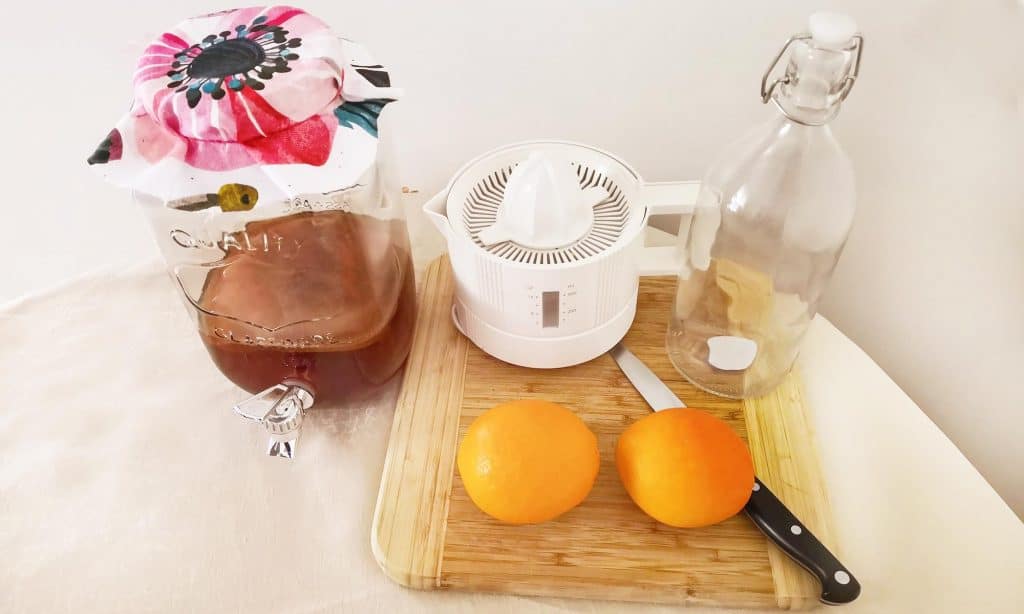
Kombucha Tea Brewing
Frequently Asked Questions
- Is Kombucha alcoholic?
Yes, but it is usually less than 0.5% to 1% and is a by- product of fermentation. Normally, it is not enough to worry about, but you can inform someone in case they are only drinking non-alcoholic drinks. - Can I use less sugar, since I like cutting down on my sugar intake?
The experts strongly recommend staying with sugar-tea-water ratio so your starter cultures will ferment and brew safely. You can use organic cane sugar but white sugar is best for brewing.
Remember that this sugar is for the SCOBY to grow and ferment; so the amount of sugar decreases as more tart your drink becomes. The longer it ferments the less sugar you have.
No one recommends using sugar replacements, not even stevia, honey or maple syrup. Experts have found that the mother SCOBY culture needs real sugar to ferment and grow good bacteria. - How long does it take to make kombucha?
If fermenting in the batch method then 7-12 days depending on your temperature and strength of your SCOBY. If brewing the continuous method you let it brew 2-4 weeks but drink it any time after 1 week, depending on the flavor. - Do you have to be 21 years old to buy, (or legal age in your state)?
No. Most local groceries or health food stores sell kombucha in the drinks or soda sections of the store; no legal laws would apply.
Kombucha drinks are not classified as alcohol. There are some companies that are now brewing Kombucha with more alcohol, they would be more than 3% and would be sold only in the beer departments or liquor stores. - Does it have caffeine?
Yes, since you use tea to brew kombucha. Tea is lower in caffeine than coffee and the longer Kombucha ferments the lower the caffeine.
You can use distilled white vinegar in place of your tea to brew, it will take longer to ferment and grow a SCOBY. - Can you drink too much Kombucha?
If you are not already drinking store bought Kombucha then experts recommend you start with 1-2 ounces. See how you react or if you can tolerate it. Increase your Kombucha drinking slowly to 8 ounces. After that you can decide how often you want to enjoy your brew, either daily or less.
More than 1 bottle or 8 ounces per day is not necessary. Fermented foods are effective in smaller doses. It is better to diversify your types of fermented foods versus just drinking Kombucha all day.
Many of us may desire to do that! But….. you can overdo the probiotic aspects of your brew! - Is it vegan?
Yes, there are no dairy or animal products in Kombucha, start to finish. - Does it contain gluten, dairy or animal products?
No, Kombucha cultures only contain filtered water, tea and organic sugar. - What are the side effects of drinking too much Kombucha?
Some individuals can react with bloating and abdominal discomfort. Some find no benefits at all. And others feel it makes them feel better from any number of various symptoms.
There is a potential to affect your teeth overtime; due to the amount of acids, if you are over-consuming Kombucha. - Does Kombucha expire?
No, as long as you have liquid covering the SCOBY, and it has not been contaminated, it can last a long time. Also, make sure you have a lid or a cloth cover on your container so it does not dry out.
You may not like the taste if it’s over 30 days and you have not added or taken out any to drink; since it will become very tart and vinegary. - Can you use flavored, decaffeinated tea or herbal teas?
Not generally since they contain essential oils which could kill the bacteria. And many are processed with chemicals if store bought or in tea bags.
You can use natural herbal tea flavorings if you know they have not been processed.
Teas like Rooibos and Hibiscus make wonderful Kombucha, and have no caffeine. Although, experts say to add about 25% green tea on every other batch for long term health of your SCOBY. - What is pH?
Your pH is your acid- alkaline balance in your body. It stands for power of Hydrogen, the pH scale goes from 1-14, 1 is acidic and 14 are most alkaline. A pH of 7 is considered neutral.
In making Kombucha, you use pH strips to get your brew in a 3.5 to 2.5 reading; this is to prevent the growth of harmful microorganisms. Gluconic acid produced in Kombucha is a pH regulator. - What is the best time to drink your Kombucha?
The advice varies, so there are no studies or set times. Try it on an empty stomach, like when you first get up in the morning or drink it with your meal to help digestion.
Let your body tell you what works better for you! - What do you do with your Kombucha, when you go on vacation?
It is good for 30 days or more just make sure it is covered with liquid so it does not get dry, it is not in direct sun and is not cold.
Kombucha brewing has many successes and some failures. Most failures are only inconveniences. This can happen to beginners and experts alike because not all of us know the answers to everything.
If you have a problem or a question not answered here comment below; usually once clarified, your brew can become a success too!
Have fun fermenting and introducing Kombucha to all your family and friends!
Related posts
How to Grow Your Own Kombucha SCOBY
Kombucha Pills and Capsules – Simple and Easy Fermented Supplements

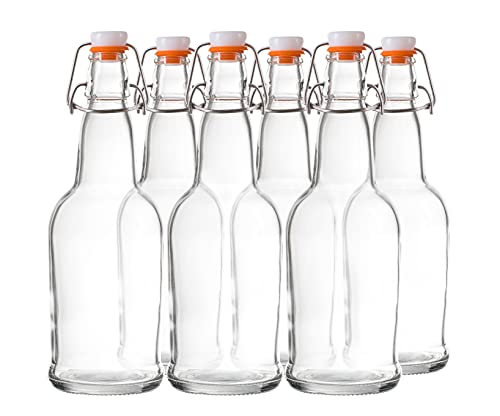


Leave a Reply